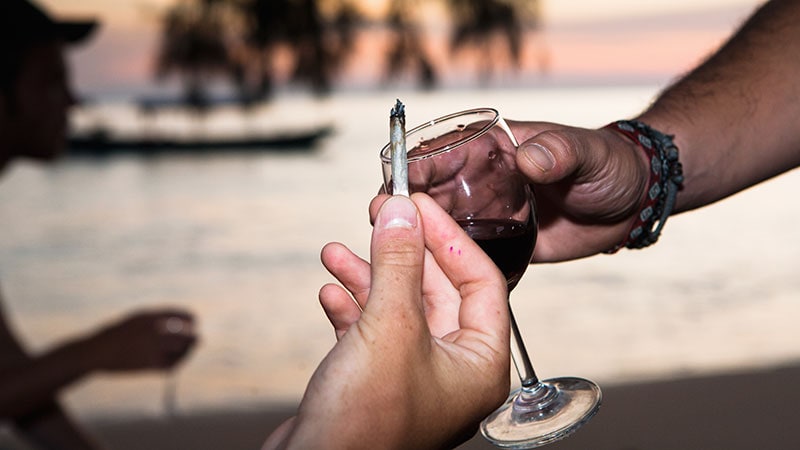Simultaneous Marijuana, Alcohol Use Linked to Worse Outcomes
Simultaneous Marijuana, Alcohol Use Linked to Worse Outcomes Medscape



TOPLINE:
Young adults who simultaneously use alcohol and marijuana (SAM) consume more drinks, are high for more hours in the day, and report more negative alcohol-related consequences.
METHODOLOGY:
-
The 2-year study included 409 people aged 18-25 years with a history of simultaneous alcohol and marijuana use (50.9% were women; 48.2% were non-Hispanic White; 48.9% were college students).
-
Participants completed daily online surveys about substance use and negative substance-related consequences for 14 continuous days every 4 months.
TAKEAWAY:
-
Alcohol use was reported on 36.1% of survey days, marijuana use on 28.0%, and alcohol and marijuana use on 15.0%.
-
Negative substance-related consequences were reported on 28.0% of drinking days and 56.4% of marijuana days.
-
SAM use was reported in 81.7% of alcohol users and 86.6% of marijuana users.
-
On SAM use days, participants consumed an average of 37% more drinks, with 43% more negative alcohol consequences, were high for 10% more hours, and were more likely to feel clumsy or dizzy, compared with non-SAM use days.
IN PRACTICE:
“This finding should be integrated into psychoeducational programs highlighting the risk of combining alcohol and marijuana,” the authors write. “A more nuanced harm-reduction tact could also encourage young adults to closely monitor and limit the amount of each substance being used if they choose to combine substances.”
SOURCE:
The study was conducted by Anne M. Fairlie, PhD, University of Washington, and colleagues, and funded by the National Institute on Alcohol Abuse and Alcoholism. The study was published online September 18 in Alcohol Clinical and Experimental Research.
LIMITATIONS:
Study participants were recruited based on their substance use and lived in a region where recreational marijuana is legal, so the findings may not be generalizable to other populations. Substance use and consequences were self-reported and subject to bias.
DISCLOSURES:
The authors have reported no relevant financial relationships.
For more Medscape Psychiatry news, join us on Twitter andFacebook
Credit:
Lead image: The Image Bank / Getty Images
Medscape Medical News © 2023 WebMD, LLC
Send comments and news tips to news@medscape.net.
Cite this: Simultaneous Marijuana, Alcohol Use Linked to Worse Outcomes – Medscape – Sep 19, 2023.
SDGs, Targets, and Indicators
1. Which SDGs are addressed or connected to the issues highlighted in the article?
- SDG 3: Good Health and Well-being
- SDG 10: Reduced Inequalities
- SDG 16: Peace, Justice, and Strong Institutions
2. What specific targets under those SDGs can be identified based on the article’s content?
- SDG 3.5: Strengthen the prevention and treatment of substance abuse, including narcotic drug abuse and harmful use of alcohol (target)
- SDG 10.2: By 2030, empower and promote the social, economic, and political inclusion of all, irrespective of age, sex, disability, race, ethnicity, origin, religion, or economic or other status (target)
- SDG 16.1: Significantly reduce all forms of violence and related death rates everywhere (target)
3. Are there any indicators mentioned or implied in the article that can be used to measure progress towards the identified targets?
- Percentage of survey days with reported alcohol use (indicator for SDG 3.5)
- Percentage of survey days with reported marijuana use (indicator for SDG 3.5)
- Percentage of survey days with reported simultaneous alcohol and marijuana use (indicator for SDG 3.5)
- Percentage of drinking days with reported negative substance-related consequences (indicator for SDG 3.5)
- Percentage of marijuana days with reported negative substance-related consequences (indicator for SDG 3.5)
Table: SDGs, Targets, and Indicators
| SDGs | Targets | Indicators |
|---|---|---|
| SDG 3: Good Health and Well-being | SDG 3.5: Strengthen the prevention and treatment of substance abuse, including narcotic drug abuse and harmful use of alcohol | – Percentage of survey days with reported alcohol use – Percentage of survey days with reported marijuana use – Percentage of survey days with reported simultaneous alcohol and marijuana use – Percentage of drinking days with reported negative substance-related consequences – Percentage of marijuana days with reported negative substance-related consequences |
| SDG 10: Reduced Inequalities | SDG 10.2: By 2030, empower and promote the social, economic, and political inclusion of all, irrespective of age, sex, disability, race, ethnicity, origin, religion, or economic or other status | N/A |
| SDG 16: Peace, Justice, and Strong Institutions | SDG 16.1: Significantly reduce all forms of violence and related death rates everywhere | N/A |
Note: The article does not provide specific indicators for SDG 10 and SDG 16.
Behold! This splendid article springs forth from the wellspring of knowledge, shaped by a wondrous proprietary AI technology that delved into a vast ocean of data, illuminating the path towards the Sustainable Development Goals. Remember that all rights are reserved by SDG Investors LLC, empowering us to champion progress together.
Source: medscape.com

Join us, as fellow seekers of change, on a transformative journey at https://sdgtalks.ai/welcome, where you can become a member and actively contribute to shaping a brighter future.







